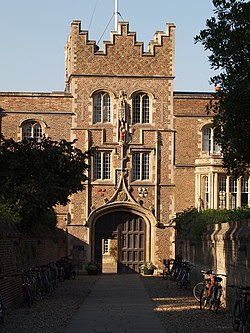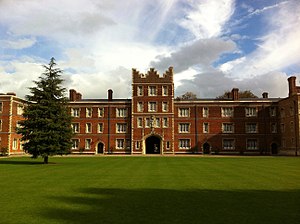Jesus College, Cambridge
| Jesus College
| |||||||
|
Prosperum iter facias | |||||||
|---|---|---|---|---|---|---|---|
 College gatehouse, from the "Chimney" | |||||||
| Master: | Sonita Alleyne | ||||||
| Website: | jesus.cam.ac.uk | ||||||
| |||||||
| Location | |||||||
| Grid reference: | TL45185890 | ||||||
| Location: | 52°12’33"N, 0°7’24"E | ||||||
The College of the Blessed Virgin Mary, Saint John the Evangelist and the glorious Virgin Saint Radegund, within the City and University of Cambridge, commonly known as Jesus College is a constituent college of the University of Cambridge.[1] The college's common name comes from the name of its chapel, Jesus Chapel.
Jesus College was established in 1496 on the site of the twelfth-century Benedictine nunnery of St Mary and St Radegund by John Alcock, then Bishop of Ely. The cockerel is the symbol of Jesus College, after the surname of its founder. For the 300 years from 1560 to 1860, Jesus College was primarily a training college for Church of England clergy.[2]
Jesus College has assets of approximately £344 million making it Cambridge's fourth-wealthiest college. The college is known for its particularly expansive grounds which include its sporting fields and for its proximity to its boathouse. Three members of Jesus College have received a Nobel Prize. Two fellows of the college have been appointed to the International Court of Justice.
History
When founded in 1496, the college consisted of buildings taken over from the Nunnery of St Mary and St Radegund, which was founded at the beginning of the 12th century; the chapel is the oldest university building in Cambridge still in use and predates the foundation of the college by 350 years, the university by half a century.
The Benedictine Convent, upon dissolution, included the chapel and the cloister attached to it; the nuns' refectory, which became the college hall; and the former lodging of the prioress, which became the Master's Lodge. This set of buildings remains the core of the college to this day and this accounts for its distinctly monastic architectural style, which sets it apart from other Cambridge colleges. A library was soon added, and the chapel was considerably modified and reduced in scale by Alcock. At its foundation, the college had a master, six fellows and six scholars.[3]
Buildings and grounds
Entrance
The main entrance to Jesus College is a walled passage known as the "Chimney". The term is derived from the Middle French word cheminée, for "little path" or "little way". The Chimney leads directly to the Porter's Lodge and then into First Court. All the courts at the college, except for the cloister, are open on at least one side.
Chapel
The College Chapel was founded in 1157 and took until 1245 to complete, and is believed to be the oldest university building in Cambridge still in use. Originally it was the chapel of the Benedictine Convent of St. Mary and St. Radegund, which was dissolved by Bishop John Alcock.
The original structure of the chapel was cruciform in shape and the nave had both north and south aisles. A high, pitched roof was surmounted by a belfry and steeple; this collapsed in 1277. The chapel was also used as the parish church of St Radegund. Twice the chapel was ravaged by fire, in 1313 and 1376.
When the college took over the precincts during the 15th century, the parish was renamed after the college as Jesus parish, with the churchyard still being used for burials. This, however, was short-lived, as by the middle of the 16th century Jesus' parish was absorbed into that of All Saints. Significant alterations were carried out to the church under Alcock, transforming the cathedral-sized church, which was the largest in Cambridge into a College chapel for a small group of scholars. A large part of the original nave was replaced by College rooms, and subsequently part of the Master's Lodge.
The misericords were created by the architect Augustus Pugin between 1849 and 1853. Pugin used fragments of the misericords dating from 1500, which had been preserved in the Master's Lodge as templates. Repairs were also undertaken by George Frederick Bodley between 1864 and 1867, who commissioned decorative schemes from Morris, Marshall, Faulkner & Co.[4] The same firm returned in the 1870s to install stained glass.[5]
Outside links
| ("Wikimedia Commons" has material about Jesus College, Cambridge) |
References
- ↑ Walker, Timea (2022-02-02). "Jesus College" (in en). https://www.undergraduate.study.cam.ac.uk/colleges/jesus-college.
- ↑ History
- ↑ Society of gentlemen (1780). The Biographical Dictionary, Or, Complete Historical Library: Containing the Lives of the Most Celebrated Personages of Great Britain and Ireland, Whether Admirals, Generals, Poets, Statesmen, Philosophers, Or Divines : a Work Replete with Instruction and Entertainment. F. Newbery. p. 30. https://books.google.com/books?id=8jtQAQAAIAAJ.
- ↑ Naylor, Gillian, ed (1988). William Morris by himself: Designs and writings. p. 40. ISBN 9780356153209.
- ↑ Sewter, A. C. (1975). The stained glass of William Morris and his circle. II. pp. 43–44. ISBN 9780300014716.
| Colleges of the University of Cambridge | |
|---|---|
|
Christ’s • Churchill • Clare • Clare Hall • Corpus Christi • Darwin • Downing • Emmanuel • Fitzwilliam • Girton • Gonville and Caius • Homerton • Hughes Hall • Jesus • King’s • Lucy Cavendish • Magdalene • Murray Edwards • Newnham • Pembroke • Peterhouse • Queens’ • Robinson • St Catharine’s • St Edmund’s • St John’s • Selwyn • Sidney Sussex • Trinity • Trinity Hall • Wolfson |
|




